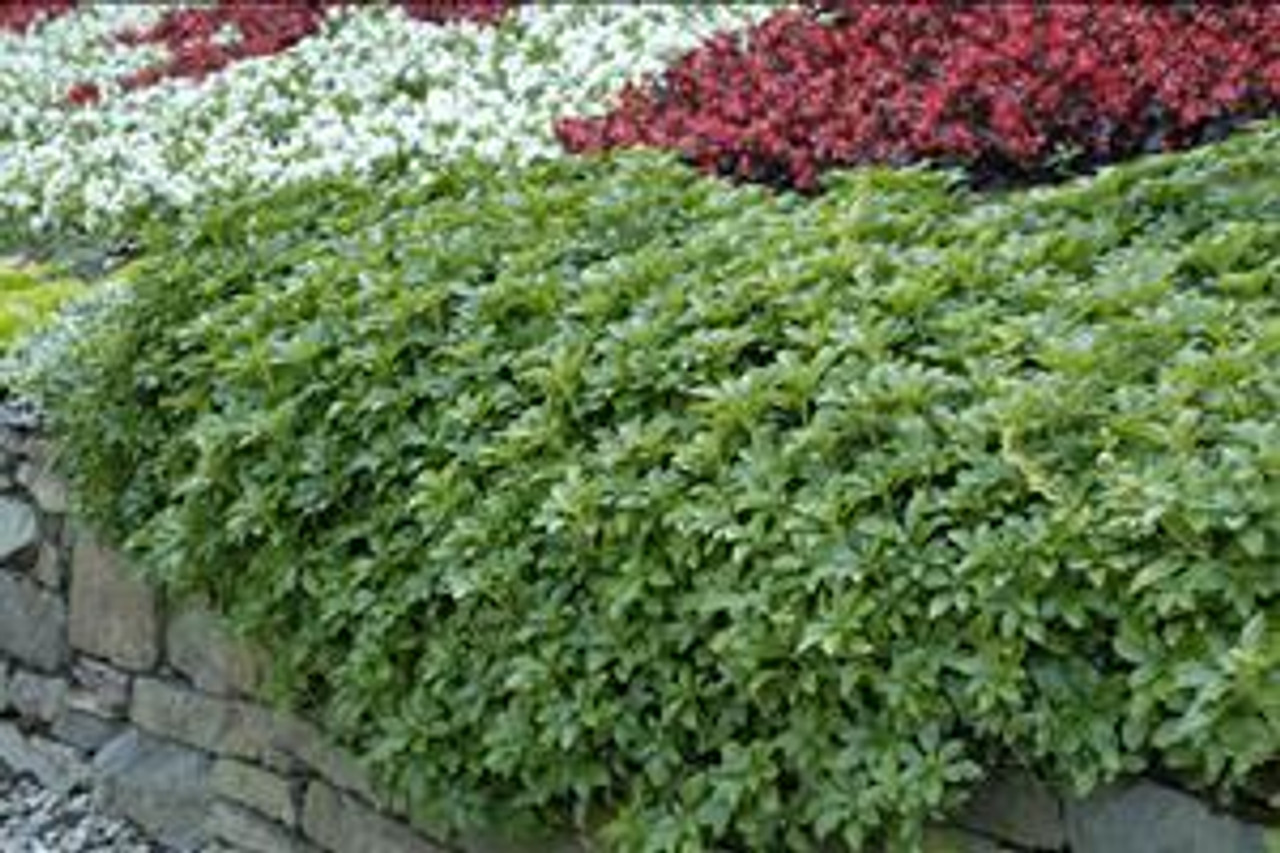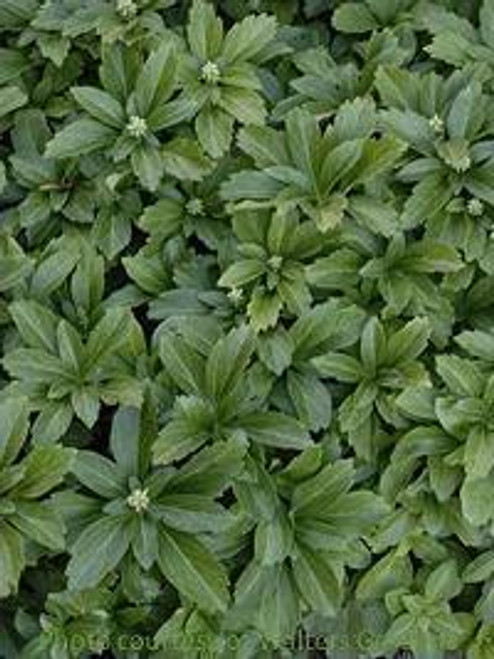Product Description
Pachysandra terminalis 'Green'
a/k/a Pachysandra, Japanese Pachysandra, or Spurge.
Zone 4 to Zone 9, partial shade to deep shade.
Medium-sized, 6 to 10 inch high; evergreen groundcover.
Pachysandra terminalis, commonly known as Japanese pachysandra or Japanese spurge.
This is a popular evergreen groundcover known for its ability to thrive in shady areas where other plants struggle. It is a great choice for adding greenery and suppressing weeds under trees, along foundations, or in other shaded spots in your garden.
Here are some key features of Pachysandra terminalis:
- Low-growing: It typically reaches a height of 6-12 inches, forming a dense mat of foliage.
- Dark green leaves: The leaves are oval-shaped, leathery, and dark green, providing year-round interest.
- Shade tolerant: It thrives in full shade to partial shade, making it ideal for difficult areas.
- Spreads easily: It spreads through rhizomes, creating a thick carpet that helps to control weeds.
- Low maintenance: Once established, it requires minimal care.
However, it is important to note that Pachysandra terminalis can be invasive in some areas, as it can spread aggressively and outcompete native plants. It is a good idea to check with your local extension office or garden center to see if it is considered invasive in your region.
If you are looking for a groundcover for a shady spot and Pachysandra terminalis is appropriate for your area, it is a solid choice. Just be sure to plant it in a contained area or be prepared to manage its spread.
Create a Lush, Evergreen Carpet with Japanese Spurge!
Pachysandra terminalis, commonly known as Japanese Spurge, is a reliable and versatile evergreen groundcover prized for its ability to thrive in shady areas where other plants struggle. This low-maintenance plant forms a dense carpet of dark green foliage, effectively suppressing weeds and adding year-round interest to your landscape.
Japanese Spurge is a popular groundcover known for its tough, adaptable nature and its ability to tolerate deep shade. It features glossy, dark green leaves that create a lush, carpet-like effect. In spring, it produces small, fragrant white flowers, adding a touch of delicate beauty to the shade garden. This plant spreads through underground rhizomes, forming a dense mat that effectively blocks out weeds and prevents soil erosion. It is a slow-growing but reliable groundcover, making it a great choice for low-maintenance gardens.
- Mature Size: 6-12 inches tall, spreading indefinitely
- Foliage Color: Dark green
- Flower Color: White
- Bloom Time: Spring
- Growth Habit: Spreading groundcover
- Light Needs: Partial to full shade (tolerates deep shade)
- Soil Needs: Adaptable to various soil types, prefers moist, well-drained soil
- Hardiness Zones: 4-9 (USDA)
- Special Features: Evergreen, shade tolerant, weed-suppressing, erosion control, low maintenance
Planting:
- Timing: Plant in spring or fall for best results.
- Location: Choose a shady or partially shaded location. Japanese Spurge thrives in areas with limited sunlight, making it ideal for planting under trees or in areas with northern exposure.
- Soil Preparation: While adaptable to various soil types, amending the soil with compost or other organic matter will improve drainage and fertility, promoting healthier growth.
- Spacing: Space plants 12-18 inches apart to allow for their spreading growth habit. Closer spacing will result in faster coverage.
- Planting Depth: Plant at the same depth as the nursery container.
- Watering: Water thoroughly after planting and regularly until it is established.
Care:
- Watering: Once established, Japanese Spurge is relatively drought-tolerant, but it benefits from consistent moisture, especially during hot, dry periods. Water deeply but infrequently.
- Fertilizing: Fertilize in spring with a balanced fertilizer to promote vigorous growth. Avoid over-fertilizing.
- Pruning: Minimal pruning is typically required. Trim any stray stems or prune lightly to maintain shape and control spread. Pruning is best done in late winter or early spring.
- Mulching: Apply a layer of mulch around the plants to retain moisture, suppress weeds, and protect the shallow roots.
- Pest and Disease Control: Japanese Spurge is generally pest and disease resistant. However, watch for occasional issues like leaf spot or scale.
Uses in the Garden:
- Groundcover: Ideal for creating a low-maintenance, evergreen groundcover in shady areas.
- Erosion Control: The dense root system helps stabilize slopes and prevent erosion.
- Foundation Plantings: Can be used as a low-growing foundation planting around homes or other structures.
- Borders and Edging: Adds a neat, defined edge to pathways or flower beds.
- Woodland Gardens: A natural choice for woodland gardens, adding texture and greenery to the understory.
Create a lush, evergreen carpet in your shade garden with the reliable and versatile Pachysandra terminalis!
Eighteen (18) plants in 3.5-inch containers per flat (or tray).
Other Details
The most important part of the plant is its root system. Healthy roots are the foundation of a healthy, vibrant plant. The type of plug container used is based on the specific needs of the plants. Perennials offered as bare root traditionally perform better when planted as bare root.Planted in a specialized mix, potted plants have well established root systems. Top growth stage will vary depending on the current life cycle and time of year when shipped. In Winter and early Spring dormant plants may be shipped. Dormant plants may be planted right away, even before the last frost date.
Most bare root varieties are field grown for at least one season, though Hemerocallis and Hosta are grown for two seasons. The bulk of the soil is removed during the harvesting process and the tops of most varieties are trimmed back to the crown. They are graded, packed in shredded aspen or sphagnum moss and stored in freezers until ready to be shipped.
See our Container Sizes and Bare Root Perennials pages for more information.
Plant information and care is provided in the Overview section, Plant Genus Page and general information is provided in the Planting Care & Guides. Additional questions can be asked on each Plant page.
Plant Spacing: Using the maximum mature spread or width of a plant to guide spacing, ensures space to grow to full size. To fill an area sooner, plant them closer together. Just remember, future thinning or transplanting may be needed.
Water: Keep a close eye on newly planted perennials, especially throughout the first growing year. Most early plant loss is due to too much or too little water!
























